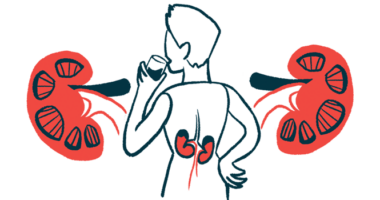Rare CFHR5 mutation likely contributed to aHUS in young girl
Girl also had high levels of self-reactive antibodies against complement factor H

A rare mutation in the CFHR5 gene may have led to the excessive activation of the immune complement system, triggering atypical hemolytic uremic syndrome (aHUS) in a 5-year-old girl, a case study reports.
The mutation in CFHR5 (which stands for complement factor H-related protein 5) was found to reduce the shedding of its resulting protein, called FHR5, which likely contributed to excessive complement system activation.
When lab-made FHR5 was added to a sample of the girl’s blood, hemolysis, or red blood cell destruction, was eased. This suggests FHR5 may protect against the excessive complement activation that drives hemolysis and aHUS, researchers noted.
The girl was also found to carry a deletion of two other complement genes and showed high levels of self-reactive antibodies against complement factor H, which could have predisposed her to develop aHUS.
The study, “Complement dysregulation associated with a genetic variant in factor H-related protein 5 in atypical hemolytic uremic syndrome,” was published in Pediatric Nephrology.
aHUS caused by abnormal activity of complement cascade
aHUS is a rare disease caused by abnormal activity of the complement cascade, a part of the immune system that triggers inflammation and blood clotting and that must be tightly regulated so it does not damage the body’s healthy cells.
Excessive complement activation can lead to hemolysis, blood clots in small blood vessels, low counts of blood clot-inducing platelets, and kidney damage, causing symptoms of aHUS.
Often, the disease can be associated with mutations in genes that encode for complement components and self-reactive antibodies against such components. However, for aHUS to fully manifest, there is usually another triggering event, such as an infection.
A team of researchers at Lund University, in Sweden, have now described the case of a 5-year-old girl with aHUS who carried a rare mutation in the CFHR5 gene and whose effects were investigated.
The girl was admitted to their clinic with hemolytic anemia, or low levels of the oxygen-carrying protein hemoglobin due to hemolysis, a low platelet count, and kidney damage. She also had high levels of self-reactive antibodies against factor H, a molecule that prevents the complement system from being activated when it is not needed.
This pointed to a possible diagnosis of aHUS, and she responded well to treatment with daily infusions of fresh frozen plasma (the cell-free part of blood), followed by mycophenolate mofetil, or MMF, an immunosuppressant, up to every other week.
aHUS symptoms returned after 1.5 years during infection
However, about 1.5 years later, symptoms of aHUS returned during an infection that caused fever, and again one month later.
The girl underwent several sessions of plasma exchange, a procedure to remove disease-causing antibodies from the bloodstream, with an additional mild disease relapse. She then received cyclophosphamide, another immunosuppressant, for five months, followed by MMF.
“The treatment protocol was in accordance with a multicenter study of aHUS patients with antibodies to factor H,” the researchers wrote.
The girl did not experience any more symptoms of aHUS, and MMF was slowly tapered and discontinued when she was 15 years old. Over a period of 11 years, her anti-factor H antibodies decreased by more than 60 times, from 16,460 E/mL in 2012 to 260 E/mL in 2023.
While she had no known family history of aHUS, genetic testing revealed a deletion of both copies of CFHR3 and CFHR1, two complement genes linked to aHUS. She also carried a rare mutation, called M514R, in one copy of the CFHR5 gene, which codes for FHR5.
Her father was found to carry one copy of the CFHR3/CFHR1 deletion and one copy of the M514R mutation, whereas her mother had one copy of the CFHR3/CFHR1 deletion. None of the parents tested positive for anti-factor H antibodies.
The exact function of FHR5 remains unknown, but the protein is similar in structure to factor H, suggesting it may play a similar role in keeping the complement system in check.
Blood samples from the girl and her father showed lower FHR5 levels relative to samples from five healthy people (0.76-0.8 vs. 1.49-3.1 micrograms per mL).
Adding rabbit-derived red blood cells to a sample of the girl’s serum — the part of the blood that remains after blood cells and clotting proteins have been removed — induced hemolysis, which decreased significantly in the presence of lab-made human FHR5.
“This was also demonstrated using the father’s serum (carrying the same CFHR5 variant without antibodies to factor H),” the researchers wrote.
“The results suggest FHR5 has a regulatory role on the surface of [red blood cells] and its deficiency could thereby contribute to complement activation leading to hemolysis,” the team wrote.
Comparison of lab-grown human cells with normal CFHR5 gene or mutated gene
To understand how the M514R mutation affected FHR5 protein levels, the team compared lab-grown human cells carrying either the normal CFHR5 gene or the mutated gene.
The team found cells carrying the normal CFHR5 gene released high levels of FHR5 to the surrounding solution, while the mutated FHR5 was found at very low levels. Further analyses showed the mutated version, instead, accumulated inside the cells, at levels 8.5 times higher than those found in cells producing the normal protein.
This provided a possible explanation as to why the M514R mutation led to low circulating FHR5 levels.
These findings suggest “two factors in the patient’s serum may have played an important role in the development of aHUS; the antibodies to factor H and the CFHR5 variant,” the team wrote.
“The antibodies to factor H most likely contributed to the development of disease as she responded well to plasma exchange and immunosuppressive treatment. However, we speculate that the decreased FHR5 could also promote complement activation as FHR5 was shown here to protect [red blood cells] from complement-mediated [destruction],” they added.
While “it seems that levels of anti-factor H antibodies play a more important role in the induction of disease …the CFHR5 variant [mutation] may have an additional role in promoting complement activation once the disease has been triggered,” the researchers concluded.









